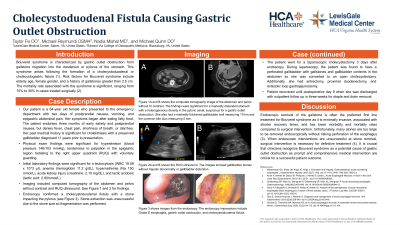Monday Poster Session
Category: Biliary/Pancreas
P1871 - Cholecystoduodenal Fistula Causing Gastric Outlet Obstruction
Monday, October 28, 2024
10:30 AM - 4:00 PM ET
Location: Exhibit Hall E

Has Audio
- NM
Nadia Mishal, MD
Lewis Gale Medical Center
Salem, VA
Presenting Author(s)
Taylor M. Fix, DO1, Nadia Mishal, MD1, Michael Reymundi, 2, Michael Quinn, DO1
1Lewis Gale Medical Center, Salem, VA; 2Edward Via College of Osteopathic Medicine, Roanoke, VA
Introduction: Bouveret syndrome is a rare condition characterized by gastric outlet obstruction from gallstone migration into the duodenum or pylorus of the stomach. The syndrome arises following the formation of a cholecystoduodenal or cholecystogastric fistula. Risk factors for Bouveret syndrome include elderly age, female gender, and a history of gallstones greater than 2.5 cm. The mortality rate associated with this syndrome is significant, with a nonoperative rate 26.5% and a surgical rate ranging from 15% to 30%.
Case Description/Methods: A 64-year-old female presents with upper abdominal pain, nausea, and vomiting. Her past medical history is significant for cholelithiasis with a preserved gallbladder diagnosed 11 years ago, endometrial cancer in remission, stage 4 chronic kidney disease, osteoarthritis, and gout. Contrast enhanced computed tomography (CT) of the abdomen revealed a distended stomach and concern of gastric outlet obstruction. Diagnosis was confirmed during endoscopy which showed a cholecystoduodenal fistula and gallstone in the duodenal bulb impacting the pylorus. Mechanical endoscopic fractionation was performed, followed by cholecystectomy and fistula repair.
Discussion: The preferred therapeutic intervention for Bouveret syndrome is debatable. Endoscopic removal of the gallstone is often preferred first line as it is minimally invasive, associated with shorter recovery times, and has lower morbidity and mortality rates compared to surgical intervention. Unfortunately, many stones are too large to be removed endoscopically without risking damage or perforation of the esophagus. When endoscopic interventions are unsuccessful at stone removal, surgical intervention is necessary for definitive treatment. The patient underwent successful cholecystectomy and stone removal, but initial laparoscopic approach was complicated by presence of a perforated gallbladder with gallstones and gallbladder contents in the abdomen, leading to an open cholecystectomy. Such a transition led to a prolonged recovery time with eventual full recovery. It is crucial that clinicians recognize Bouveret syndrome as a potential cause of gastric outlet obstruction as it is associated with a significant mortality rate when not diagnosed in a timely manner. Prompt and comprehensive medical intervention are critical for a successful patient outcome.
Disclosures:
Taylor M. Fix, DO1, Nadia Mishal, MD1, Michael Reymundi, 2, Michael Quinn, DO1. P1871 - Cholecystoduodenal Fistula Causing Gastric Outlet Obstruction, ACG 2024 Annual Scientific Meeting Abstracts. Philadelphia, PA: American College of Gastroenterology.
1Lewis Gale Medical Center, Salem, VA; 2Edward Via College of Osteopathic Medicine, Roanoke, VA
Introduction: Bouveret syndrome is a rare condition characterized by gastric outlet obstruction from gallstone migration into the duodenum or pylorus of the stomach. The syndrome arises following the formation of a cholecystoduodenal or cholecystogastric fistula. Risk factors for Bouveret syndrome include elderly age, female gender, and a history of gallstones greater than 2.5 cm. The mortality rate associated with this syndrome is significant, with a nonoperative rate 26.5% and a surgical rate ranging from 15% to 30%.
Case Description/Methods: A 64-year-old female presents with upper abdominal pain, nausea, and vomiting. Her past medical history is significant for cholelithiasis with a preserved gallbladder diagnosed 11 years ago, endometrial cancer in remission, stage 4 chronic kidney disease, osteoarthritis, and gout. Contrast enhanced computed tomography (CT) of the abdomen revealed a distended stomach and concern of gastric outlet obstruction. Diagnosis was confirmed during endoscopy which showed a cholecystoduodenal fistula and gallstone in the duodenal bulb impacting the pylorus. Mechanical endoscopic fractionation was performed, followed by cholecystectomy and fistula repair.
Discussion: The preferred therapeutic intervention for Bouveret syndrome is debatable. Endoscopic removal of the gallstone is often preferred first line as it is minimally invasive, associated with shorter recovery times, and has lower morbidity and mortality rates compared to surgical intervention. Unfortunately, many stones are too large to be removed endoscopically without risking damage or perforation of the esophagus. When endoscopic interventions are unsuccessful at stone removal, surgical intervention is necessary for definitive treatment. The patient underwent successful cholecystectomy and stone removal, but initial laparoscopic approach was complicated by presence of a perforated gallbladder with gallstones and gallbladder contents in the abdomen, leading to an open cholecystectomy. Such a transition led to a prolonged recovery time with eventual full recovery. It is crucial that clinicians recognize Bouveret syndrome as a potential cause of gastric outlet obstruction as it is associated with a significant mortality rate when not diagnosed in a timely manner. Prompt and comprehensive medical intervention are critical for a successful patient outcome.
Disclosures:
Taylor Fix indicated no relevant financial relationships.
Nadia Mishal indicated no relevant financial relationships.
Michael Reymundi indicated no relevant financial relationships.
Michael Quinn indicated no relevant financial relationships.
Taylor M. Fix, DO1, Nadia Mishal, MD1, Michael Reymundi, 2, Michael Quinn, DO1. P1871 - Cholecystoduodenal Fistula Causing Gastric Outlet Obstruction, ACG 2024 Annual Scientific Meeting Abstracts. Philadelphia, PA: American College of Gastroenterology.
